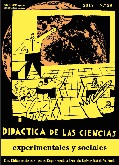Ethnobotany: a science of proximity for scientific education in secondary school
DOI:
https://doi.org/10.7203/dces.47.29492Keywords:
Ethnobotany, Environmental Education, Traditional Knowledge, Sustainable Development Goals, Educational Innovation in Science Abstract
Abstract
In this study, ethnobotanical content (understood as the endemic cultural heritage and traditional knowledge of plants) is integrated into the Biology and Geology curriculum of 1st-year secondary school education (1º de ESO) to facilitate meaningful learning. The design of the intervention, its development with an expository methodology, and the design and application of analysis and evaluation tools are presented. Non-parametric statistical analysis was used to assess cognitive learning and attitudes towards sustainability, science, and their learning. Students showed significant improvements in learning and sustainable awareness, confirming the effectiveness of incorporating traditional knowledge into the curriculum to enhance scientific learning and sustainability awareness, in line with the Sustainable Development Goals.
 Downloads
Downloads
Downloads
Published
How to Cite
-
Abstract76
-
PDF (Español)36
Issue
Section
License
![]()
The articles published at Didáctica de las Ciencias Experimentales y Sociales will have a Creative Common Licence Creative Commons Attribution-Noncommercial-No Derivative Works 3.0 Unported



